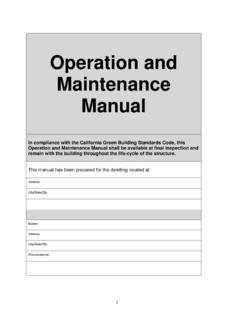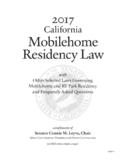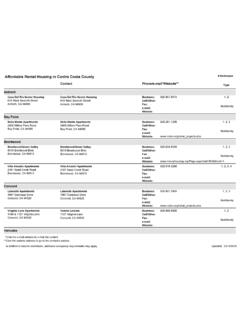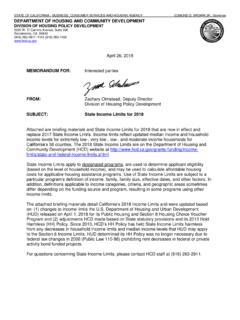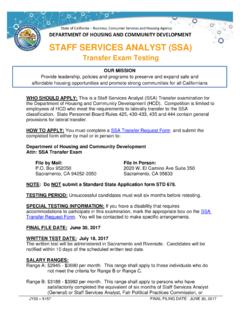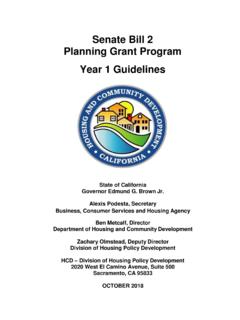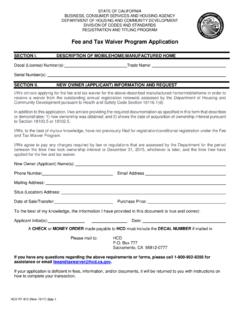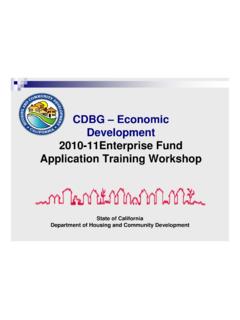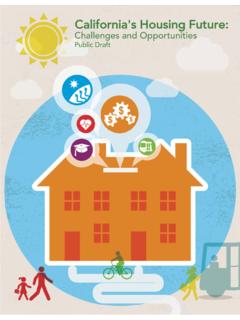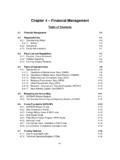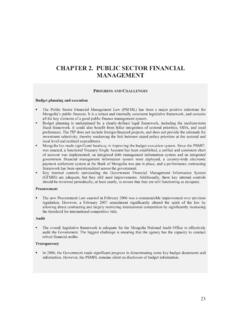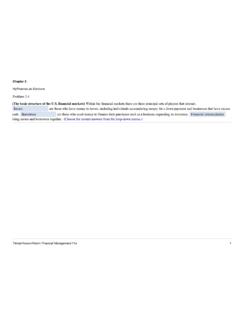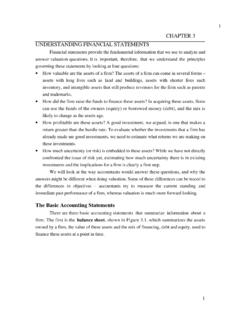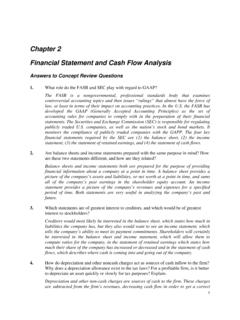Transcription of CHAPTER 3 FINANCIAL OVERVIEW FINANCIAL …
1 51 CHAPTER 3 FINAN CIA L OVERVIEW FINANCIAL management SYSTEMS Congress created the Single Audit Act of 1984 (Act) to improve auditing and management of federal funds provided to state and local governments. The Act requires a single organization-wide FINANCIAL and compliance audit for state and local governments. The Act is intended to promote sound FINANCIAL management , including effective internal controls, with respect to federal awards administered by state and local governments and nonprofit organizations. Internal controls encompass a system of accounting and administrative controls, including management and program policies, procedures and guidance that help ensure effective and efficient use of resources; prevention and detection of fraud, waste, and abuse, and the reliability of FINANCIAL reporting.
2 In addition to internal controls, the Act focuses on compliance with laws and regulations governing federal awards. Compliance refers to how well the respective agency receiving federal funds complies with the requirements in federal law, regulations, contracts, and grants applicable to each of its federal programs. The Single Audit Act Amendments of 1996 were to reduce burdens on State and local governments, and to ensure that federal departments and agencies rely on and use the audit work. All non-federal entities that expend $750,000 or more in federal awards in a year are required to have a single audit for that year in accordance with the Act, Single Audit Act Amendments of 1996 and 2 CFR Part 200 Subpart F-Audit Requirements.
3 Each year, California receives and expends billions of dollars in federal funds for numerous programs. As a condition of receiving these funds, an annual independent audit must be conducted of the State s FINANCIAL statements. This audit must also include California s compliance with the federal program regulations. The California State Auditor (State Auditor), the State's independent and nonpartisan audit, evaluation, and investigative arm of the Legislature, plays a critical role in the oversight for federal funds received by the State each year. As the State's external independent auditor, the State Auditor is the only entity that has, by statute, full access to all records, accounts, correspondence, property or other files of state and local agencies, special districts, public contractors, and school districts.
4 The State Auditor s general powers include the ability to subpoena records, take depositions, and administer oaths. The State Auditor's Office (office) is responsible for evaluating departments' administration and management of public funds and programs to assure that the proper checks and balances are in place. In addition, the office evaluates departments' compliance with laws and regulations. Although our audits encompass a wide range of topics, our staff are highly trained professionals with a depth and breadth of experience that allows them to evaluate programs and recommend ways to make government more efficient, improve management controls, and instill best 52 practices. In addition to conducting high risk assessments as authorized by statute, investigations of misconduct by state employees, and audits mandated in statute or requested and approved by the Joint Legislative Audit Committee, the State Auditor is statutorily responsible for annually conducting the statewide Single Audit.
5 If an outside audit firm is procured to perform any of the audit functions, California Contract Code Sections 10330 through 10334 apply to the procurement and contracting of the firm(s). State statutes also mandate that the State Audit be: a) conducted in accordance government and industry auditing standards, b) the independent audit of the State's basic FINANCIAL statements, and c) the independent compliance audit of numerous federal programs administered by California. As required by the Act and Single Audit Amendments of 1996, the State Auditor complies with Generally Accepted Government Auditing Standards (GAGAS) when conducting the FINANCIAL and federal compliance audit. The U.
6 S. General Accounting Office issues these standards. In addition, the U. S. Office of management and Budget (OMB) issues guidance for auditors to follow when conducting the Single Audit. This guidance is intended to provide for consistency and uniformity for the audit of the expenditure of federal awards by states, local governments and nonprofits. The California Single Audit Report encompasses all state agencies that expend federal funds. HCD is committed to ensuring that policies and practices are in place to make certain that all federal, state and local program rules, regulations, statutes and best practice standards are being met. If HCD-managed programs are named in any Single Audit Reports as a finding, HCD reviews the issue and the practices that lead to the finding, determines what process changes are needed to become compliant, and implements the necessary changes.
7 Process changes will include adequate oversight and monitoring to assure ongoing compliance. The State of California s annual FINANCIAL statements and single audit reports are available to the public on the State Controller s Office (SCO) website. FINANCIAL reports are located at ; single audit reports are located at This comprehensive annual Single Audit fulfills the provisions of the federal Single Audit Act of 1984, Single Audit Act Amendments of 1996, and 2 CFR Part 200 Subpart F-Audit Requirements. FINANCIAL management REPORTING SYSTEMS California s State Accounting & Reporting system (CALSTARS) is the State s FINANCIAL management system . The CALSTARS manual is located on the Department of Finance website at 53 ), while the general FINANCIAL policies are available at HCD staff track grant awards, obligations, unobligated balances, and expenditures, using the Department s Consolidated Automated Program Enterprise system (CAPES), HUD s Integrated Data Information system (IDIS) or Disaster Recovery Grant Reporting system (DRGR), as well as CALSTARS and internal Department reports.
8 California s accounting procedures are in accordance with Generally Accepted Accounting Standards (GAAS) and require that source documentation be entered into CALSTARS. A review and approval of documents to ensure that the expenditures are eligible and valid is required before transactions are recorded in CALSTARS. HUD requires each Grantee to use the online Disaster Recovery Grant Reporting (DRGR) system to process draw requests, report progress and program narratives for each project expenditure and administration draws. HCD will report a recap of the progress and expenditures, as well as any challenges or obstacles in the required quarterly progress reports in DRGR. HUD will use DRGR data to monitor for anomalies or performance problems that suggest fraud, abuse of funds, and duplication of benefits; to reconcile budgets, obligations, fund draws, and applicable administrative and public service limitations and the overall percent of benefit to low- and moderate-income persons, and as a basis for risk analysis in determining a monitoring plan.
9 HCD FINANCIAL OVERVIEW The Department of Housing and Community Development has eight divisions: Administration and management , Audit & Evaluation, Codes and Standards, Executive, FINANCIAL Assistance, Housing Policy, Legal Affairs, and Legislation. The FINANCIAL Assistance Division manages the federal programs. The Department s Standard Agreement, the contractual document between HCD and the entities that are awarded funds to carry out specific, eligible activities (contractors), details the FINANCIAL and recordkeeping requirements and standards for the Grantees. Grantees must permit the State, federal government, the Bureau of State Audits, the Department and/or their representatives, upon reasonable notice, unrestricted access to any or all books, records, accounts, documentation, and all other materials relevant to the agreement for the purpose of monitoring, auditing, or otherwise examining said materials.
10 All records, books, accounts, documentation and all other materials relevant to the federal funding must be maintained for a minimum period of five (5) years after the Department notifies Grantees that the HUD/HCD contract has been closed. Once the federal fiscal year budget has been enacted and HUD announces the formula allocation amounts for the CDBG, HOME and ESG programs, HCD s FINANCIAL , Reporting, Evaluation and 54 Disbursements (FRED) Section prepares a request for a program cost account (PCA) code that allows tracking of all activity for the funds, including encumbrances (when funds are committed to a Standard Agreement), disencumbrances, expenses or payments, and/or return of funds associated to the HUD grant.
